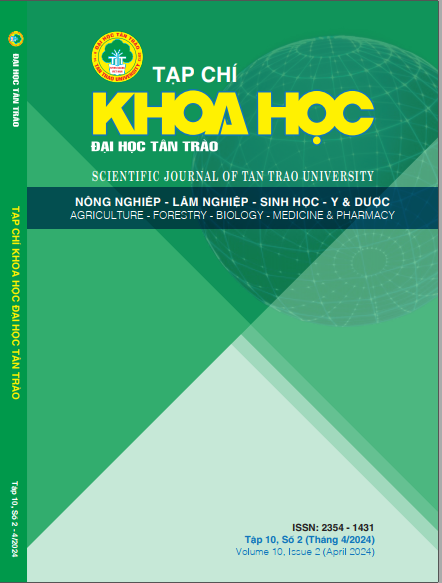STUDY OF FACTORS AFFECTING THE FERMENTATION OF PINEAPPLE JUICE
DOI:
https://doi.org/10.51453/2354-1431/2024/1078Abstract
Fermented fruit juice is a nutritious and extremely popular product today. The objective of this study is to investigate the factors affecting the fermentation of pineapple juice for processing fermented beverage products, such as dry matter concentration, initial pH of fruit juice, yeast ratio supplementation and fermentation time. The results showed that the final product reached the alcohol content at 4,07%v and the remaining post-fermentation sugar content at 6,57 oBx when the initial pineapple juice was adjusted with a soluble dry matter concentration of 20 oBx, pH = 3.8, the yeast addition at 0,03% and the fermentation time of 96 hours. The fermented pineapple juice product had a high sensory score according to TCVN 3215-79 and exhibited harmonious and light aroma of ethyl alcohol.
Downloads
References
Akubor, P.I., Obio, S.O., Nwadomere, K.A. and Obiomah, E (2003). Production and qualityevaluation of banana wine. Plant Foods forHuman Nutrition, 58(3): 1-6.
Cagno, R.D., Filannino, P., & Gobbetti, M (2016). Fermented Foods: Fermented Vegetables and Other Products. Agricultural and Food Sciences, 668 - 674.
Duong D.T (2020). Sustainable development for Vietnam agriculture. Web Conf, 175:1–9.
Nguyen M. T (2013). Stablization and improving the quality of Rose myrtle wine using chemical and biological methods. Can Tho University Journal of Science, 14: 195-204.
Luong D. P (2010). Fermentation technology.Viet Nam Education Publishing House.
Nguyen-Viet H., Tuyet-Hanh T.T., Unger F., Dang-Xuan S. and Grace D (2017). Food safety in Vietnam: Where we are at and what we can learn from international experiences. Infect. Dis. Poverty, 6:1–6.
Phong H.X., Klanrit P., Dung N.T.P., Yamada M. and Thanonkeo P. (2019). Isolation and characterization of thermotolerant yeasts for the production of second generation bioethanol, Ann. Microbiol., 69:1–12.
Phong H.X., Quyen M.T., Thanh N.N., Hoang B. and Long D (2017). Selection of high acid producing lactic acid bacteria and potential application in pineapple juice fermentation. Bioprocess Eng., 1:58–64.
Tien D. T. K., Nhung D. T.T., Dieu D. T.H., Thanh N. N., Mi H. T. N and Phong H. X (2021). Study of conditions for processing fermented drinking water from soursop (Annona muricata L.) using yeast Saccharomyces cerevisiae RV002. Vietnam Journal of Science and Technology, 65(5):76-80.
Tran T.H, Van C.K, Nguyen V.M and Tran T.T (2022). Production of a fermented beverage from pineapple (Ananas comosus) by product crumbs. Materials Today: Proceedings, 60: 2034–2042.
Vo T. T. L (2016). Assessment of agri-product value chains in the Mekong Delta: Problems and solutions, Can Tho Univ. J. Sci., 02:100–111.
Vietnam standard TCVN 3215-79 (1979). Sensorial analysis-Method by pointing mark for food products. Ministry of Science and Technology of Vietnam.
Vietnam standard TCVN 8008:2009. Distilled liquors - Determination of alcohol. Ministry of Science and Technology of Vietnam.
Downloads
Published
How to Cite
Issue
Section
License

This work is licensed under a Creative Commons Attribution-ShareAlike 4.0 International License.
All articles published in SJTTU are licensed under a Creative Commons Attribution-ShareAlike 4.0 International (CC BY-SA) license. This means anyone is free to copy, transform, or redistribute articles for any lawful purpose in any medium, provided they give appropriate attribution to the original author(s) and SJTTU, link to the license, indicate if changes were made, and redistribute any derivative work under the same license.
Copyright on articles is retained by the respective author(s), without restrictions. A non-exclusive license is granted to SJTTU to publish the article and identify itself as its original publisher, along with the commercial right to include the article in a hardcopy issue for sale to libraries and individuals.
Although the conditions of the CC BY-SA license don't apply to authors (as the copyright holder of your article, you have no restrictions on your rights), by submitting to SJTTU, authors recognize the rights of readers, and must grant any third party the right to use their article to the extent provided by the license.


